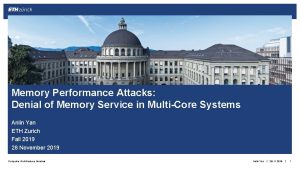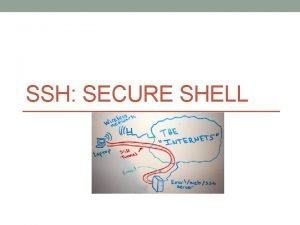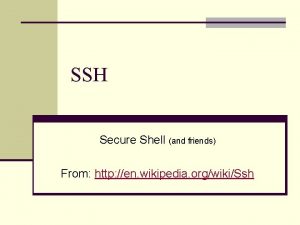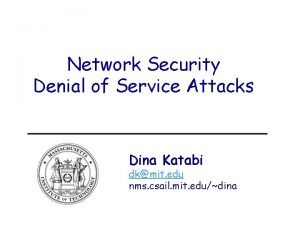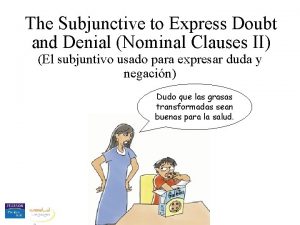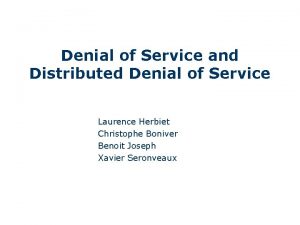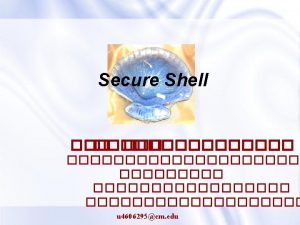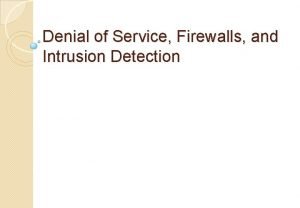Secure Shell Denial of Service Attacks Outline Secure















- Slides: 15

Secure Shell & Denial of Service Attacks Outline Secure Shell Overview Authentication Practical issues Denial of Service Attacks Definition Examples CS 640 1

Secure Shell (SSH) Overview • SSH is a secure remote virtual terminal application – Provides encrypted communication between untrusted hosts over an insecure network • Assumes eavesdroppers can hear all communications between hosts • Provides different methods of authentication • Encrypts data exchanged between hosts – Intended to replace insecure programs such as rlogin, rsh, etc. – Includes capability to securely transfer file • SCP – Includes ability to forward X 11 connections and TCP ports securely • Very popular and widely used – Not invulnerable! CS 640 2

Authentication in SSH 1 • Three means of authenticating supported by SSH – Simple rhosts • User/system names in ~/. rhosts, ~/. shosts • Vulnerable to IP/DNS spoofing • Requires specific compilation for this mode of operation – Host based • Use RSA to verify host keys • Use ~/. rhosts file for user authentication – Host and user based • RSA host key verification • RSA user key verification • If authentication fails, client is prompted for password – All communication is encrypted CS 640 3

SSH 1 Key Exchange Protocol • Server has public/private key pair – Client knows server’s public key in advance • Must be sent securely in advance • Server sends public key and random server key to client – Client verifies public key • Client sends random session key encrypted with host and server key – Rest of session is encrypted with session key CS 640 4

SSH 2 Key Exchange Protocol • Diffie-Hellman public key exchange algorithm is used – Public key exchange algorithm – very cool – Two users can exchange a secret key over and insecure link without sharing any prior secrets (!) • Digital signature verifies identity of server to client • At the end of the key exchange, a secret key is shared – Used for encrypting the rest of the session • Supports MD 5 checksums for data integrity • Supports a variety of encryption mechanisms – IDEA (default), Blowfish, DES, Triple DES, … CS 640 5

SSH in Practice • Host public/private key is generated when SSH is installed – Public key must be in ~/. ssh/known_hosts on remote systems • ssh-keygen command is used to generate users public/private keys – Requires user enter a pass phrase – Public key copied to ~/. ssh/authorized_keys on remote systems • Ssh-agent and ssh-add eliminate the need for repeated typing of pass phrase • Password authentication is vulnerable to guessing attacks • X 11 and port forwarding enable encrypted pipe through the Internet – Can be used to securely access insecure application eg. SMTP – Can be used to circumvent firewalls CS 640 6

SSH in Practice contd. • Available as open source software – See Open. SSH • Tricky to get working properly • Standard with many software distributions CS 640 7

Denial of Service (Do. S) Attacks • One of the most general forms of attacking inter-networked systems – Based on overloading end systems – Result is sever reduction in performance or complete shutdown of target systems • Focus of attacks can be network components or end hosts • We have heard about a number of these in the past year • Other most general form of attack is a break-in – Port scans – Buffer overflows – Password cracking… CS 640 8

Overloading a System • The goal of Do. S is to drown legitimate traffic in a sea of garbage traffic – Lots of traffic that has not been provisioned for pushes real traffic out of the way • Clients experience delays due to congestion – Dropped packets lead to exponential backoff in timeouts • Routers can become overloaded • Servers become overloaded by increased number of connect requests – TCP connection setup requires state and response from server – Server is required to respond to SYN from clients – Clients don’t respond to server’s response CS 640 9

IP Spoofing • Alter system to insert a different source IP address in TCP and IP headers – Do. S attackers spoof for two reasons • They don’t want to be discovered • Spoofing can additional load • If you spoof with a legitimate IP address – Reset can be triggered from either attacked host or actual IP host • Frees resources immediately on server – Careful use of sequence numbers can freeze future connections from actual IP host • If you spoof with a random number IP – Server response to client SYN will be lost – Server will not free resources for 75 seconds (typically) CS 640 10

Key Elements of Do. S Attack • Expansion in required work – Easy for me, harder for you – Expansion in IP spoofing • Me: generate SYNs as fast as possible (microseconds) • You: Timeout a SYN open every 75 seconds • Best effort protocols – Drop tail queues – No source specificity – Clients can be starved or slowed to crawl CS 640 11

Do. S Attack Characteristics • Expansion makes a only a few systems necessary – Typical goal is to attack from as many places as possible • Enables better utilization of network resources • Helps to prevent countermeasures • Helps to obscure attackers • Do. S software is readily available and/or simple to write – Most found in IRC chat rooms • Do. S attacks are frequently preceded by break-ins to install Do. S software – Enables even more anonymity for attacker CS 640 12

Facilitating Do. S Attacks • • Lots of systems Large networks Naïve users Savvy bad guys Lots of free software Poor operating and management policies Hugely complex software with lots of well publicized holes • Lack of means for stopping attacks CS 640 13

Dealing with Do. S Attacks • Don’t reserve state until receipt of client ACK – DOS attackers using spoofing don’t send these • Otherwise they would have to keep state – Use of crypto to avoid saving state • Send one-use key with server response to SYN • Response ACK must return key • Intrusion detection tools – Cut off an attack at a firewall if you recognize it – Bro, Snort • IP traceback methods • There are lots of companies in this space! CS 640 14

Code Red • Code Red Worm – Released and identified on July 19, 2001 • Infected over 250 k systems in 9 hours – Takes advantage of hole in IIS on Win NT or Win 2 k • And the fact that most people don’t know IIS ON is default – Infected systems are completely compromised – Code Red installs itself in OS kernel • Small and efficient • V 1 could be eliminated by reboot – Spends half its time trying to infect other systems, and half its time Do. S’ing the White House and Pentagon CS 640 15
 Shell cleanliness shell soundness shell texture shell shape
Shell cleanliness shell soundness shell texture shell shape Egg parts diagram
Egg parts diagram Row buffer denial of service
Row buffer denial of service Fail2ban vs denyhosts
Fail2ban vs denyhosts Ssh secure shell wiki
Ssh secure shell wiki 1. denial
1. denial Define plausible deniability
Define plausible deniability Dina denial
Dina denial Equation of emotion
Equation of emotion Rationalization defense mechanism
Rationalization defense mechanism Co227 denial code
Co227 denial code Denial of receipt letter hermes
Denial of receipt letter hermes Laarc method
Laarc method Adaptive denial dbt
Adaptive denial dbt Prayer and self denial 2021
Prayer and self denial 2021 To express doubt
To express doubt


